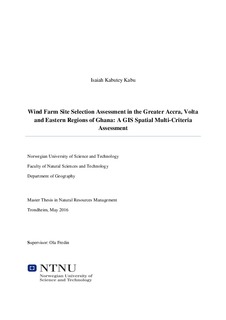| dc.description.abstract | Global temperatures have increased since preindustrial times and will continue to do so unless practical measures are taken to halt the emission of carbon and other ozone depleting substances. Wind energy alone has the potential to supply energy in greater magnitudes to a significant percentage of the world’s population with emissions of 0.02 to 0.04 pounds equivalent of CO2 per kilowatts hour per year as compared to coal’s emission of 1.4 to 3.6 pounds equivalent of CO2 per kilowatts hour. Wind is a naturally occurring resource that has been the source of energy for mankind since time immemorial. Generating electricity from the power in the wind is however relatively recent. Wind is spatially and temporally variable and so tapping the wind power for producing electricity requires location specific analysis for wind installation. This study aimed at finding suitable locations for wind farms in South Eastern Ghana in West Africa. The study area covers three administrative regions. A ten year daily records of wind run data was collected from ten stations from the Ghana Meteorological Agency in Accra, and a ten year average wind speed was assessed for them. The study area has variable wind speed records, the lowest in the Volta region and the highest in the Greater Accra region. An SMCA was used to select the suitable factors for the study and the AHP was used to apply weights to all the factors in order of importance. A weighted overlay analysis in ArcGIS 10.2 was used to produce a map of the suitable areas using land use data, power grid lines, road networks and slope calculated from Digital Elevation Model (DEM) 30m resolution. The best location with best wind speeds are in the Greater Accra region covering some 86288 hectares of land. The second objective of this study was to find the initial estimate of electricity that can be produced from the selected areas. The wind speed of the selected areas was extrapolated to hub heights of 80m. The new wind speed used for estimating the electricity production is 3.6m/s. The Power law was applied using a swept area diameter of 100m, a hub height of 80m and 3.6m/s wind speed. The total initial estimate of power that can be generated is 10551MW, 1.2MW per turbine. The country can see economic transformation if this energy is added to the power grids and the surplus can be exported to countries in the sub region. The study shows that Ghana has capacity for wind energy which needs to be developed. Future studies must consider site specific measurement of wind speeds at the selected areas in the other regions as they are more spatially variable than the Greater Accra region since so the meteorological data cannot reliably interpolate wind speeds across those regions. Ground measurements at hub heights need to be conducted at the selected best sites in the Greater Accra region to ascertain the true wind conditions. | nb_NO |
